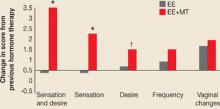Elevated androgen levels have both ill and good effects
As I stated earlier, an appropriate level of androgen is optimal for women as well as men. Elevated androgen levels are problematic, in that they are the hallmark of PCOS, usually resulting from increased ovarian production of androgen. This elevation can cause anovulation, infertility, hirsutism, and other androgen-mediated physiologic effects. Androgen is also associated with elevated low-density lipoprotein and decreased high-density lipoprotein cholesterol, implying a possible relationship with cardiovascular disease. At the same time, however, elevated testosterone has been correlated with increased bone density in both the hip and the femoral neck.9
It is clear that appropriate androgen secretion, which does not elicit the side effects described above, is best for both the health and well-being of the woman.
How androgen affects female sexual function
We have known for years that androgen—not estrogen—is associated with satisfactory sexual function. Although estrogen replacement increases vaginal lubrication, it is androgen, most commonly in the form of oral methyltestosterone or injectable testosterone, that increases frequency of intercourse, desire, and sexual sensation (FIGURE 2).10 The definition of androgen insufficiency has been hotly debated, and is currently “a pattern of clinical symptoms in the presence of decreased bioavailable testosterone and normal estrogen.”11
FIGURE 2
How estrogen plus androgen affects sexual function
*P<.01; †P=.05
EE=esterified estrogens; MT=methyltestosterone
SOURCE: Sarrel PM, et al19
Assessing androgen levels
Clinical signs and symptoms of androgen insufficiency are important in establishing the diagnosis. They include a diminished sense of well-being, unexplained fatigue, decreased sexual desire, and thinning and loss of pubic hair.11 Although it is possible to assess testosterone production and availability in women by measuring serum testosterone levels, a lack of consensus about the best measurement technique and interpretation of results makes it difficult to base the diagnosis of androgen insufficiency solely on serum levels.12 Therefore, the diagnosis of androgen insufficiency is primarily a clinical diagnosis of symptoms.11
Obtain serum samples between 8 and 10 AM after day 8 and before day 20 of the normal menstrual cycle because testosterone is subject to diurnal variation, peaking in the early morning, as well as cyclic variation, peaking around midcycle.
Because free testosterone is the only bioavailable steroid, total testosterone and either free testosterone or SHBG must be measured to assess how much androgen is actually available. From total testosterone and SHBG, one can assess the free testosterone index as a measure of bioavailable androgen (the free testosterone index is a ratio of the amount of total testosterone divided by the SHBG level).11 In fact, using the free testosterone index is preferable to the actual measurement of free testosterone because commercial assays lack the sensitivity and reliability to accurately measure the low levels of androgen found in women.
Several different testosterone assays exist, and the immunoassay for total testosterone is reasonably accurate. However, measurements of free testosterone are relatively inaccurate and poorly reproducible. Equilibrium dialysis is thought to be the gold standard for measuring free testosterone, but it is a difficult and time-consuming assay.12
Causes of low testosterone
In women, low testosterone secretion is usually the result of normal aging. Other conditions that alter testosterone production include oophorectomy, ovarian failure, adrenal insufficiency, hypopituitarism, and other forms of chronic illness.
Treatment with corticosteroids and estrogen therapy lowers active androgen levels in women.
What levels are cause for concern?
If androgen levels are at or below the 25th percentile of the normal range for reproductive-aged women, consider the possibility of androgen insufficiency and determine whether androgen replacement is in order.11
When the signs and symptoms of testosterone insufficiency are present, one must first assess estrogen levels by measuring serum estradiol, obtaining vaginal cytology, or both, and by determining whether symptoms of estrogen insufficiency are present, such as hot flashes, night sweats, and vaginal dryness. If the patient is estrogen-insufficient, the first step in resolving her symptoms is estrogen replacement. If estrogen levels are adequate and there is no other reason for the patient’s symptoms of fatigue, lack of sexual desire, or low energy, a trial of testosterone is reasonable.
Treating androgen insufficiency
Current therapies include oral methyltestosterone combined with estrogen, and intramuscular testosterone propionate, testosterone cypionate, and testosterone enanthate. Subcutaneous implants of testosterone propionate are also available, as are transdermal preparations (TABLE 2). However, the transdermal formulations are designed for androgen insufficiency in men, and therefore deliver approximately 10 times as much androgen as women normally produce. Testosterone gel preparations are available that can be applied in lower levels to achieve normal female androgen levels.


